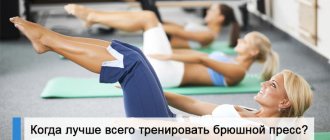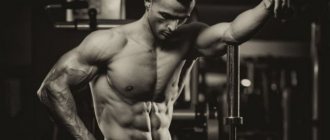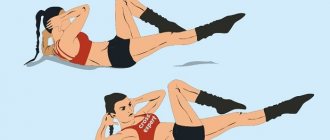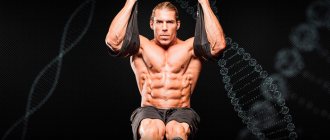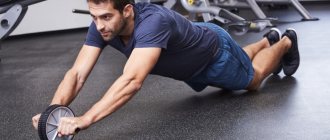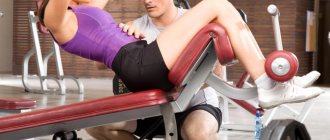Basic twist options
A classic exercise - the most common abdominal crunches are performed on the floor. The main load here will fall on the rectus abdominis muscles and its upper part. In this case, the lower back practically does not compensate for muscle tension.
This is an ideal exercise for pumping up the abdominal muscles, it is so effective that only with this exercise you can achieve sculpted abs, but subject to diet.
This exercise is performed from a supine position with bent knees. The fingers are interlocked and fixed at the back of the head.
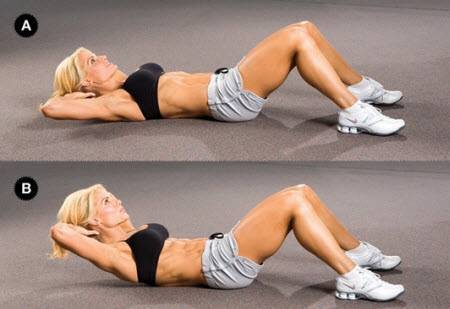
Try to spread your elbows to the sides. After this, tighten your abdominal muscles and begin to lift your upper body up, trying to bring your ribs closer to your hips. Make sure that this lift is performed without jerking, both during lifting and lowering. To avoid losing your equipment, watch the video.
https://youtube.com/watch?v=JC66T_zUkFI
Rotate while twisting
Another type of exercise for the upper abs is crunching on the floor with a turn. Here the exercise technique will be the same as in the previous version, only during the rise you will need to turn the body towards one leg, then towards the other.
The exact same exercise can be done from a standing position, but then the right elbow and the opposite left leg will twist diagonally and simultaneously meet in the center of the body. Then we change the position to the opposite.
Twisting on an inclined horizontal bench
This load is performed on a special projectile. You need to secure your legs under special supports. We do everything else as in the above options.
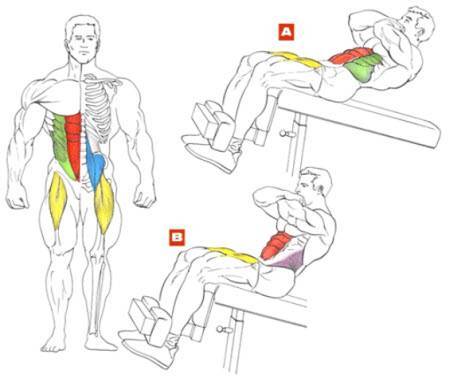
Make sure that it is the abdominal muscles that are working.
Using a block
You need to calculate the load so that you can do 20 or 25 repetitions. Turn around to face the block and get on your knees. Firmly grasp the handle of the block and begin to pull it towards the floor.
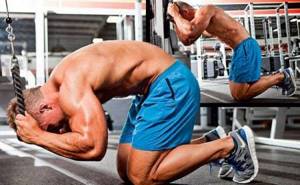
At the same time, you must perform crunches and use all the abdominal muscles as much as possible. Return to the starting position. This exercise must be performed in such a way that your muscles are constantly tense.
You can practice this complex while standing. This will allow you to achieve a stronger range of motion and increase productivity.
Please note that the gym usually has different handles for such machines that allow you to change the load. The handle can also be wound either in front of you or behind your back.
We work on our sides
This type of load is aimed at working out the oblique muscles. It can be used both on the floor and on a special inclined bench. How to do abdominal crunches in this case?
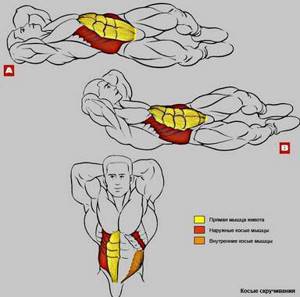
If you decide to load your muscles on a bench, then lie down so that your body is suspended, and the fulcrum is only in the hips. To secure the body, you will definitely need an assistant to sit on your feet. Turning your face to the wall, you must bend and straighten your body so that all the oblique muscles are involved in the work.
It is much easier to do it on the floor; you just need to lie down on the floor and start doing it.
Leg Raise
This exercise can also be found under the name reverse abdominal crunch. If in previous variations we almost always raised the upper body, then in this one we will tear off the lower part of the body from the surface.
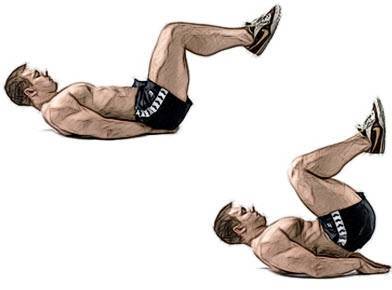
There are two options: on a bench or on the floor. On the bench, you should grab the edge with your hands so that you can hold on.
https://youtube.com/watch?v=FA1-25gRNDw
While lying on the floor, simply stretch your arms along your body to provide yourself with support. In the starting position, the legs are bent at the knees. We begin to do twisting and raise the lower limbs to perpendicular to the floor. We pull our knees to our chest, and so that the pelvis does not come into contact with the surface.
Analysis of the exercise
Anatomy of an exercise: which muscles work?
The Russian twist is a forming movement for the abdominal muscles, based on lateral twisting of the body.
The following muscle complex takes on the load:
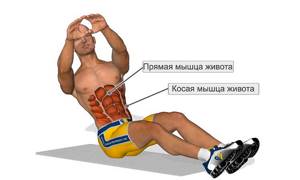
Preparing for the exercise
Before doing an abdominal workout, a general warm-up is usually sufficient. To prepare the spine and “warm up” the oblique muscles, you can additionally perform the following exercises: lying on your side with your knees bent, lean back and try to touch the floor behind your body with your palm or while standing on all fours, alternately tilt your pelvis first to the left, then to the right, trying to touch the floor with your thigh.
How to do it correctly
Errors
Efficiency Tips
Inclusion in the program
In terms of difficulty of execution, single movements can compete with Russian twists. Because of this, it is recommended to perform the exercise immediately after the main training block for large muscle groups in a volume of 15-20 repetitions in 3-5 sets.
Contraindications
The Russian twist involves the lumbar region, and therefore poses a potential danger for athletes with injuries in this area (especially intervertebral hernias and osteochondrosis).
Avoid doing crunches if you experience discomfort in your back, or try replacing them with a safer version of the exercise on a fitball.
How to replace the Russian twist
In principle, all abdominal crunches are suitable as exercise substitutes. In addition, bicycle crunches and side planks are effective for the side press.
Features of Russian twists, muscles worked
The Russian twist allows you to expend a large amount of energy during its execution: the work includes both the abdominal muscles (rectus, transverse, internal and external oblique muscles), as well as the muscles of other parts of the body - the back, arms, legs and even the chest. I'm not even talking about the stabilizer muscles (core muscles), which are responsible for the balance of the body. And you will have to hold it, believe me.
In addition, this exercise allows you to use various types of weights, ranging from a small dumbbell to the most ordinary barbell. But more on that later. Therefore, it is also quite possible to pump up your abdominal muscles to a six-pack: it will happen even faster.
In addition, coordination of movements develops well: the first time I tried to do this twist with a “bicycle” (movements with your legs, like pressing on the pedals), and I admit, it turned out clumsily. But over time, nothing, I became more experienced.

Pros and cons of Russian crunches
Pros of the exercise:
- Thanks to the peculiarities of the technique, the exercise trains not only the external abdominal muscles, but also the internal ones, which are responsible for maintaining the spine and the correct position and functioning of the internal organs. Relaxed internal abdominal muscles cannot hold the lower back in the correct position, which causes lumbar hyperlordosis to form.
- The exercise, when performed in large numbers of repetitions, forms a muscle corset, visually improves the shape of the muscles and indirectly helps to reduce waist size, especially with the right loads and nutrition. Exercise itself does not burn fat locally in this area. And lifting weights makes the muscles thicker and more defined.
Advantages and features of the training
Simple crunches have a number of advantages, which is why they can be found in any comprehensive program. The advantages of the technology include:
- increased strength of the abdominal wall muscles;
- strengthening the muscle corset;
- improved posture;
- increasing the body's endurance;
- fat burning and relief in the abdominal area;
- a wide range of activity options.
By pumping your abs, you use the rectus abdominis, pectoral, external (internal/oblique), and transverse muscles. Training has a positive effect on the functioning of internal organs and systems, since they receive more oxygen under the influence of physical activity.
You don't need to train every day. 2-3 times a week will be enough. It is necessary to give muscle tissue time to recover; this is the only way you will achieve positive results and notice the effect of your work on your figure.
Watch a video with the correct technique for performing abdominal crunches:
(No ratings yet)
Variations of the exercise
Among the varieties of Russian twists, the following can be distinguished:
With knee lift
This version is a little more complicated than the classic one. Knee lift or bicycle crunches. While rotating the body, you add lift to the same knee and try to move it in the direction opposite to your hands.
With legs fixed
Fixed foot position will allow you to twist your body more intensely. You can put your feet under the bench or ask your partner to hold them.
Additional burden
If you want to make your life even more challenging, grab a small barbell plate or weights. In this case, you can fix your feet, or you can keep them suspended, as in the classic version. Hold the weight in front of you on outstretched or bent (it’s easier) arms and perform the movement.

Rotations of the pelvis instead of the body
This variation allows you to focus the load on the lower part of the abdominal muscles. In the starting position, you lie on your back, and your legs are raised up and bent at the knees at a right angle. You can spread your arms to the sides to maintain balance. Move your knees alternately to the right and left, making sure that there is no deflection in the lower back.
On fitball
The technique for performing the exercise is the same as in the classic version, only you lie with your back not on the floor, but on a fitball. This option is considered safer for the spine.
With T-bar
A rather exotic version of the exercise, performed while standing. So, you stand straight, feet shoulder-width apart and slightly bent at the knees. Hold the T-bar with your arms straight in front of you at shoulder level. Hold the bar by the end of the bar on which the plates are put on. The abs are tense, the back is straight, there is no arch in the lower back. Move your arms with the barbell from side to side to the extreme accessible point, while simultaneously twisting your body and hips.
So, we looked at the classic version of the movement and six of its variations. The Russian twist is an excellent multivariate exercise that will allow you to effectively pump up your oblique abdominal muscles and get the figure of your dreams.
More articles on topics: Obliques :: Press :: Rectus abdominis
Effective exercises:
- Diagonal crunches on the floor
- How to do waist bends
- Incline Bench Crunch
Trainer's Tip: Stretching after a workout will help prevent injury and improve blood circulation in your muscles.
Exercise technique
Let's consider the classic version of the exercise, on the basis of which a lot of different variations have been invented:
- Sit on the mat and bend your knees, lean back slightly. Your torso should form a "V" shape with your hips. The back is slightly rounded in the lower back, the abs are tense. Extend your arms forward. For convenience, you can join your palms.
- Raise your legs off the floor and begin twisting your body and arms to the right and left. The knees, in turn, remain in place or slightly rotate in opposition to the body.
It is recommended to do 20–25 twists in each direction, in 3–4 approaches.
For effective abdominal training, the abdominal muscles should be fully loaded. That is, almost to the point of numbness and the inability to perform another repetition.
How to lose weight in the stomach and not pump over muscles
As much as we might want it, working out your abs won't help you burn belly and flank fat. That is, if you are overweight, you will certainly tighten and strengthen your figure, but relief will not appear until the amount of fat in the body changes.
Regarding weight loss, there is a golden rule - you need to consume less than you receive. That is, in order to achieve the goal you need to either reduce your diet, or increase physical activity, or all together. And then the magnificent relief of the sides and six-pack abs will not take long to appear. Intensive twisting, by the way, entails significant energy consumption.
The second fact concerns pumping up the oblique muscles and, accordingly, saying goodbye to the dream of a narrow waist. For most people, abdominal exercises are recommended to be performed without additional weights and in a large number of repetitions. This also applies to Russian twists.
Of course, for more intensive muscle training, you can use a small small plate or weights, but this should only be done if your goal is not to narrow your waist, but to increase the volume of your muscles to enhance their definition. Below we will show variations of Russian crunches without additional weight and with the use of weights. So there is enough exercise for everyone!
Technique for performing Russian twists
We take the starting position: sit on the floor, bend your knees (not too much), place your feet on the floor. Straighten your arms in front of you (they should look forward and upward), tilt your torso slightly back (arms are just at chest level), palms can be joined. If you are a complete beginner athlete and are not confident in your abilities, I advise you to fix your feet: ask a friend or girlfriend to hold them for you, put them under a bench, of which there are plenty in gyms, under heavy dumbbells (one leg - one dumbbell).
That's it, we sat down and got ready to work. Now you need to turn your torso to the side with your arms straightened in front of you. Turn all the way. Then we return to the starting position, stopping briefly, and do the same, but for the other side of the body.
Repeat the required number of times (15-20 in 4 approaches - for beginners). Over time, you can safely lower the phase of returning to the starting position: we immediately turn in the other direction without stopping. If you can do this, it means you have already strengthened your abdominal muscles and core muscles.
Methods of performing Russian twists, selection of difficulty
The simplest method is the one described above: without weights, with your feet fixed, sitting on the floor. But at some point the body will adapt, and this load will no longer be enough (even with a large number of repetitions and approaches). Therefore, I offer options for advanced levels (increasing difficulty).
With minor burdens. This can be either a dumbbell (weight), or a ball with sand inside, or a disk (a barbell plate). We are now talking about a reasonable weight of a couple of kilos or a little more. In these variations of the execution, you can keep your feet still motionless (a friend holds you or a bench), or with them lifted off the floor. In the second case, the abs and hips receive additional load, but the amplitude of turns is slightly reduced, although this is not a fact: maybe you are very flexible.

Exercises with heavy weights are different in that the weights will already be heavier (logical, isn’t it?). But you can also modify the Russian twist: add some elements to the execution
For example, when working with a ball filled with sand (or something else, it doesn’t matter), with each turn, hit it on the floor, catch it, and do the same for the other side. It’s even more fun this way, I think
With two dumbbells and kettlebells: Place two apparatuses on one side. You need to drag them from side to side. They turned around, moved one weight, and turned another. Now in the opposite direction.
With other simulators and equipment. For example, with a loop rubber expander or a block exercise machine (one side of the crossover). Attach the expander to something stable and make turns in both directions: on one side you will receive a lot of resistance, but on the other you will not. Then change your body position to work evenly on both sides of the body. The picture is similar when using a block.
On fitball. This option is safe for the lower back (can be done for hernias, protrusions, etc.). The difference is that the feet continue to stand on the floor, and the back lies on the fitball. By the way, you can hold any weighting material in your hands. That's it, we make turns.
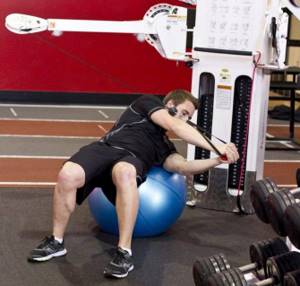
With a barbell. This type is most interesting to guys. We load one end of the bar with weights (how many do you need?), grab this edge and lift it (the opposite one is on the floor). Now step back a little so that your arms are straight (a small distance between you and the projectile will interfere with execution). By the way, your arms should be straight throughout the entire execution. So, lower the barbell sideways to the left, then the same amount to the right. Nothing complicated, I think.
With its own weight. The difficulty lies in the fact that you have to monitor the balance of the body. As for me in the case of adding “bicycle” leg work. Sit on the edge of the bench, feet off the floor, body slightly tilted back. Make turns to the sides in time with the movement of your legs. At first, it may look like normal walking (like you are walking on air), but over time, try to do exactly the “bicycle”. You can also pick up some kind of projectile.
In general, based on what level of preparedness you are at, choose the appropriate exercises. Well, how do you like the information? If you liked it, I look forward to your comment and subscription to the blog. You can also share the material with your friends: maybe they will be interested in it too. Strong six-pack abs to everyone, good luck.
- 5
- 4
- 3
- 2
- 1
Rating: 5 out of 5 (2 votes)
Subscribe and be the first to know about new articles on the site, directly in your email:
Execution technique
The Russian twist is a moderate exercise and does not require a special level of preparedness. But experienced trainers strongly advise paying attention to even the smallest details so that the exercise in question will bring the desired results in the shortest possible time. To perform the exercise correctly you must:
- Prepare a training ground. To do this, lay a rug on the floor and sit on it. At the same time, you need to understand that while performing the Russian twist, only the buttocks will be our fulcrum.
- Tighten the rectus abdominis muscles and lift your legs and torso off the surface. The lower limbs should be slightly bent at the knee joints, and the upper limbs should be straightened and brought together in front of the body. The latter must be kept straight and at a certain angle in relation to the plane of the body. So we have taken the starting position, maintaining which a person receives persistent static tension on the abdominal muscle group.
- Go to dynamic movements. To do this, inhale and, without changing the position of the lower extremities, exhale while turning the body to the right. We pause for a moment at one point and squeeze our abdominal muscles. Then we return to the starting position and make an identical movement, but to the left. Repeat as many times as necessary.
You can clearly see how to correctly perform the movements described above in this video.
Standard training
Abdominal crunches are the main exercise for working the rectus abdominal muscles. This is the basics that you need to know, because it is this movement that underlies all abdominal training.
Proper movements are important in all types of workouts. In half an hour of pumping muscles by doing abdominal crunches, you can burn about 200 kcal. The technique boils down to the following:
- Starting position – lying on the floor, alternatively, on a bench.
- Your legs should be placed above your head at an angle of 90 degrees, throwing them on a sofa, chair or other surface. You can just rest them against the wall. This allows you to eliminate the gap between the horizontal surface and the lower back.
- Hands can be positioned in different ways. The further the palms are from the pelvis, the greater the load and the more difficult the workout. The classic version is hands on the back of the head.
- Next, we inhale, and as we exhale we make an effort, i.e. we twist the body towards the pelvis. The movement must be done slowly and rhythmically.
- The back should be rounded, do not try to keep it straight. This is the #1 mistake all newbies make.
- Having achieved maximum muscle contraction at the top point, fix the position for a couple of seconds and lower to the original position, but not all the way. The muscles you want to pump up should not relax even for a second.
Standard crunches at home or in the gym can be performed at the beginning or end of the program. The choice is up to the athlete. You need to start training with 3 approaches of 10-12 times. When the body adapts, you can increase the load to 5 sets of 15-20 times. When performing regular abdominal crunches, remember that the effectiveness of the workout depends not on the quantity, but on the quality of the movement.

Recommendations
Experienced athletes and fitness trainers do not recommend starting abdominal work with lateral crunches; it is better to complete the workout with this exercise. When performing the technique, do not arch your back to avoid pinching the intervertebral discs of the lower back. Do not make sudden movements of the head - there is a risk of injury to the cervical vertebrae.
What to replace
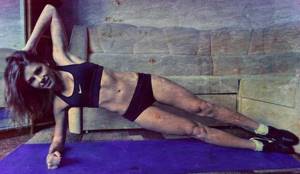
An alternative twist variation is the side plank. The exercise pumps up the abdominal and butt muscles, burns excess fat, and protects the spine from injury. The starting position is to lie on your side, lean on one hand.
Then slowly lift your hips off the floor; the back is straight, without arching. Stay in the position until you feel a strong tension in your abs and supporting arm. Then repeat the exercise on the other side.
Variations
To increase the intensity of tension, various variations of the Russian twist are used:
- Performing the exercise with fixed legs. The essence of the exercise is that a partner or a device that will help immobilize the lower limbs of the person performing the turns will allow the latter to concentrate on more intense body movements.
- Execution with knee lift. This variation allows you to slightly complicate the exercise. When turning to the side, a person needs to bring the knee of the same half of the body closer to the body and move it to the side opposite to the hands. You can also supplement the body turns with a “bicycle”.
- Russian twist on fitball. To perform this, we lie with our backs on the ball, placing our feet wider than shoulder level so that they stand flat and firmly on the surface. We bend our knees at a right angle, stretch our arms in front of the body. Next we perform body rotations.
When performing the last variation, it is worth remembering that the fitball should be rolled over the back of the shoulders, and the final amplitude will be determined by the parallel position of the arms to the floor. This type of exercise is characterized by greater safety in relation to the spinal column.
- Performed with additional weights. To make it more difficult, you can pick up small dumbbells, barbell plates, weights, or other weights that are convenient for holding with outstretched arms. If you decide to lift significant weight, bend your elbows for easier execution.
- Russian twist with rotations of the pelvis instead of the torso. This variation is used to shift the center of tension to the lower abdominals. When you take the starting position, the body will now be on the surface, and the legs will be raised up and bent at the knee joints at a right angle. To maintain balance, your arms can be spread to the sides. Next, we move our knees, as we did with the torso, to the left and right sides. Make sure that your lower back does not sag.
- Russian twist with T-bar. Perform in a standing position, with legs bent at the knee joints, positioned shoulder-width apart. In the starting position, hold the T-bar straight in front of you with straight arms. At the same time, we hold the bar by the end closer to which the pancake/pancakes are located. We remember that you should perform the exercise with a straight back, without bending in the lumbar region, keeping the abdominal muscles in constant (static) tension. We move our arms with the barbell to the sides to the extreme possible point, twisting the body and hips.

